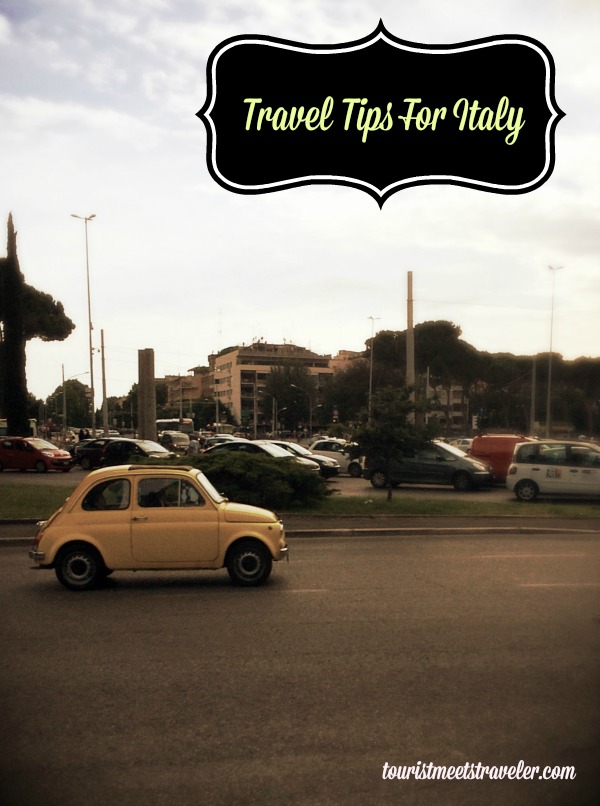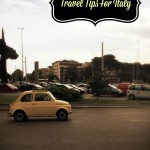Travel Tips For Italy: Understanding and Planning Your Italian Vacation
Prior to my first trip to Italy, I did a little research. Actually, I did a lot of research. Not only on where to stay and what to see, but I was also interested in the dynamics of Italian culture. I wanted to know the do’s and don’ts, what’s frowned upon, and what’s downright unheard of. I felt like I was well prepared when I took off to Rome but I was very very wrong. I encountered many surprises while in Italy. While most were pleasant surprises, they all contributed in some way to my culture shock.
Looking back now, I just have to chuckle a bit about the many times I got lost, was given weird looks, and laughed alongside friendly locals at my many mispronunciations. It goes along with the experience and I’m happy to have had the chance to live it first-hand. Now that I’m back from my trip, I feel like I should my experience with others. So, if you’re heading to Italy soon, (first off let me just say that I am very jealous of you), I hope these Italy travel tips and FYI’s will be helpful in making your time in Italy run a little smoother. Inevitably, you will experience some “Aha” moments of your own but it’s all part of the fun in traveling.
- Cash and exact change is the preference. While this is not necessarily true for restaurants and stores that cater specifically to tourists, it is certainly true for smaller mom and pop eateries and stores. I found that many small shops in Italy do not accept credit cards and many shops and restaurants prefer cash. Not only do they prefer cash, but they also prefer exact change or close to it. So if you’re buying gelato for 2,40 euros, they’re likely expecting you to give them no more than 3 or 5 euros. The reasoning is that in many cases, they simply do not have change to give you if you pay with bigger bills. What I found to be helpful was to ask for change or make a purchase with a larger bill when I was in more touristy areas as they were more likely to have smaller bills or coins on hand.
- Avoid high conversion fees by using ATMs. Before heading to Italy, check with your bank to see how much the cross border fee is for using your credit card and withdrawing cash using your debit card abroad. More likely than not, the fee will be around 1% which is far better than the rates that currency exchange locations charge.
- Bus and metro tickets are interchangeable. The same tickets are used for both the bus and the metro so you can purchase tickets at the automated machines in the metro station and also use it for the buses.
- Buy bus tickets before boarding and plan alternate routes. You must have a pre-purchased ticket before boarding the bus. Tickets are not sold on board the bus. Of course, no one officially checks your ticket when you come on the bus but I’ve heard that they do randomly check tickets from time to time. So, getting caught without one could cost you. You can purchase tickets from any tobacco shop or store designated with a blue T sign at the top. Once you have your ticket, if you have access to an Internet-accessible phone, enter your destination in Google Maps. Maps will give you several options for bus routes. For example, one route might be to take Bus 23 directly to the Vatican while another will tell you to take Bus N2 to Bus N64. Taking Bus 23 might seem like the faster option but that particular bus could take over an hour to arrive. Instead, take the first bus on your options of routes.
- Plan ahead to cut through the lines at popular sites. You can buy your tickets to popular sites such as the Vatican Museums and Sistine Chapel and the Colosseum and Roman Forum online. Then, bring your printed ticket with you on the day of your visit and walk straight to the front of the line. Other sites such as the Pantheon and the lesser known San Clemente Basilica have no lines at all!
- Prepare for lapses in phone/data service. I relied heavily on Google Maps while I was in Italy because my T-Mobile plan does not charge for roaming. Most of the time, it worked but when we hit Naples, there was absolutely zero service. And if you’ve ever been to Naples, you know that the street signs aren’t exactly consistent. I was completely lost for two hours and ended up having a cab take me to my destination. Take it from me and plan ahead in case your phone gives out.
- If you’re ready for the check, ask for it. When Italians sit down for a meal, they commit to the experience. Reigning true to the premise of the slow food movement which began in Italy, the Italian culture’s belief is that slow service is good service. Why? Because in Italy, meals are savored and the dining experience is a time to take it slow and be among good company and good food. As a result, the waiter will never rush you and will only bring you the check when asked.
- Tipping is not necessary. Waiters in Italy make a living wage and, in some cases, restaurants will automatically add a service charge to your bill. Locals are known not to tip, or not significantly anyway. They may round up on their bill and leave the change or tip when the service they receive is extraordinary. In any case, waiters do not expect a tip so it’s not necessary to leave one.
- In Italy, sparkling water is the norm. When you order water at a restaurant, the waiter will typically ask if you want sparkling water or still water. In other words, they may also ask if you want your water with gas or without gas. What they’re asking is if you want carbonated or uncarbonated water. From what I experienced in Rome, the norm for nearly all locals is to drink carbonated water. Even when buying water in the grocery stores, there is a larger selection of carbonated water than there is of “still” water. So, be sure to check the labels and specify what you want to your waiter.
- Latte is milk, not a coffee with milk. Ordering a “latte” in Italian means milk. Be sure to specify that you want a caffelatte if what you really want is some coffee with milk.
- House wine costs just as much as soft drinks. In some cases, I found that a glass of house wine was even cheaper than your average coke. And have I mentioned that most house wines you’ll find in Italian restaurants are pretty terrific? It makes sense why it’s a rarity that you would ever find locals having dinner without a bottle of vino on their table. The reality is that the wine is good and, in comparison to other beverages, it’s cheap! So, the question in Italy shouldn’t be why have wine with your meal but rather, why not?





